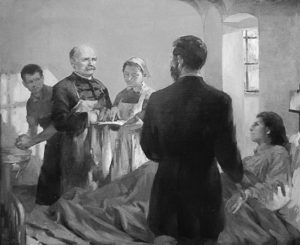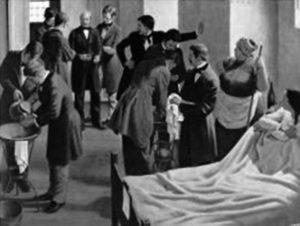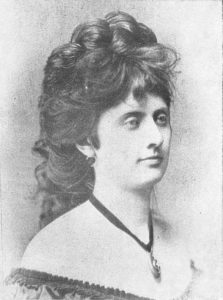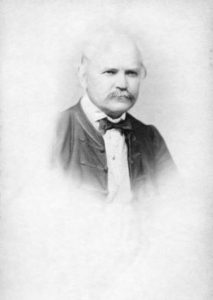
Pasteur’s discoveries vindicated the “saviour of mothers”.
Tha last photograph of Semmelweis, 1864.
“You have a part in this massacre, teacher!”
Ignác Semmelweis
Ignác Semmelweis On 31 July 1867 the forty-seven-year-old Professor of Medicine, together with his wife and child, visited the clinic of a dermatologist friend in Vienna. During the coach journey from Pest the doctor played and sang songs with his daughter. The long journey tired him, and so he gladly accepted a guest-room that he was offered in the clinic to take a rest. When he woke again and wanted to find his family nurses barred his way at the door. They informed him that he was in an institution for nervous disorders, to which he had been admitted as a lunatic. He tried to resist and to break out of the room, but there were six of them opposing him. When, after a lengthy time, the straitjacket was taken of him he tried to escape through the window. He was beaten severely, several bones were broken and his chest was perforated. Injured from head to foot he wept for nights on end, tied down. His wife and friends did not visit him. For lack of medical attention his wounds festered and he developed septicaemia. His agony went on for days, but no priest was summoned to him so that no one should witness what had been done to him. After terrible suffering he died, two weeks after his arrival.
Finally, the entry in the register of deaths was falsified; according to the official account septicemia resulting from a previous injury had been the cause of death. Only after his funeral was his death announced, and the papers printed brief obituaries to him. In his native country he had not been considered a particularly important person, and Pesti Napló (Pest Diary) only wrote: Doctor Semmelweis, teacher at Pest University, as we learn through private channels, died yesterday morning in Vienna. May his remains rest in peace. It was many years before he began to be called world-wide the saviour of mothers. Ignác Semmelweis had not been mad but had only clung passionately to the truth. He was an unpleasant man because he proclaimed teachings that were unpalatable to the world of medicine. His family and friends let him down, and his posterity kept the story of his life and death a secret for more than another century.
He was born in 1818, fifth child of a German merchant family that had migrated from Austria to Buda. Although his mother-tongue was German he called himself a Hungarian from his schooldays, and later made a show of his nationality at every opportunity. His father intended him to become a military lawyer, and so at the age of nineteen he was sent to the law faculty of Vienna University. He was not, however, interested in a legal career, and after his first year transferred to the medical school. To punish him for this his father called him home to Pest, but he could not be dissuaded from a medical career. Eventually he returned to Vienna and there completed his studies. He would have liked to be a specialist in internal diseases, but could not find a vacancy and so took a course in obstetrics, and at the age of twenty-six was able to work as an unpaid resident at Professor Klein’s famous No. 1 maternity clinic. In 1846 he was made an assistant lecturer, and his work consisted of dissecting patients who had died. In his new sphere of work the most noticeable problem in the clinic stuck him at once. One mother in ten died of puerperal fever, and in some years even more. The young doctor began to investigate the connection between the deaths and circumstances at the clinic.
According to accepted theory the deadly infection was caused by some cosmic force, while others blamed lack of ventilation or, indeed, too much of it. Some maintained that the small bell carried by the priest administering extreme unction inspired such fear in expectant mothers that they died in the days following the delivery. As a doctor I could not visualise how fear, that state of mind, could lead to such material changes as puerperal fever did, Semmelweis wrote later. Nevertheless he carried out an experiment: the priest was admitted to the building in secret, without a bell, but incidence of puerperal fever – naturally – remained at the same level. It occurred to him that expectant mothers who did not enter the clinic but gave birth at home or in the street never died. He also observed that in the maternity clinic where midwives were trained, where circumstances were in principle similar, there were half as many cases of puerperal fever as in the University clinic where he worked. There was one essential difference between the two maternity units: in the medical department clinic dissections for educational purposes were also regularly performed. Semmelweis sensed that the problem had something to do with these autopsies. He confirmed that the number of cases always decreased when there were no medical students on the premises. By then he was accumulating statistical links, but his theory had not yet been formed. In the spring of 1847 he went on a trip to Venice, to have time to think over his findings in peace and quiet. On returning home he was informed that a young pathologist colleague had died after cutting his finger with a dissecting knife while carrying out an autopsy. The answer came in a flash: I was shocked in my entire being, and I was thinking about it with unaccustomed passion in an agitated frame of mind when suddenly a thought brought me up short – puerperal fever and Kolletschka’s illness were one and the same. The discovery was not at all self-explanatory: medical science was not yet aware of the existence of bacteria and other living pathogens. Semmelweis, therefore, formulated his theory that the cause of puerperal fever was nothing other than ptomaine.

He had, with his own hands, handled decomposing organic matter, and realised at once that he himself and his colleagues had been directly responsible for the flood of deaths of women that had recently given birth. The solution to the problem seemed clear: However painful, however overwhelming such a recognition is, countermeasures are not to be found in denial; and if we do not wish this misfortune to persist the truth has to be brought to the knowledge of all concerned. He immediately introduced in the maternity unit the washing of hands in bleach to prevent doctors being able to carry ptomaine to patients. Later he ordered that doctors and nursing staff must wash their hands between inspections of patients. The result spoke for itself: in May 1847 thirty-six new mothers died in the clinic, in June only six, and in July only three. Semmelweis thought that the discovery was so unequivocal that it was enough to obey the rules logically and other clinics would follow the example of Vienna. He was to be disappointed. By autumn the incidence of puerperal fever was rising again because doctors had begun to take the instruction less than seriously. It seemed excessively simple and at the same time scandalous that they themselves were responsible for the spread of disease. Nor was it easy to accept spiritually. One of the best-known obstetricians, who had accepted his Hungarian colleague’s theory, realised that he himself had caused the death of his niece. He fell into depression as a result and not long afterwards threw himself under a train. It is not surprising that despite the favourable results the majority were reluctant to take cognisance of the discovery. Semmelweis was in despair at the scornful dismissal. All this aroused in me such an unhappy state of mind that did not make life enviable in the least. Everything was in doubt, everything remained unexplained, there was room for doubt in everything and the only indisputable reality was the great number of dead. His supporters, a dermatologist and an internist, made known the significance of the discovery in brief communications, but the breakthrough did not come. Obstetricians working elsewhere did not believe the favourable clinical results and simply thought that Semmelweis was a fool.

During the events of 1848 Semmelweis remained in Vienna, and although he joined the National Guard he was mainly involved with his private revolution. That was, however, on the brink of failure. Although the proportion of deaths had fallen to 1.3% Semmelweis irritated Professor Klein by harping on the same subject, and so in 1849, he dismissed him from the clinic. He was unemployed for eighteen months, after which he decided to try his luck in Pest. He took a post as an unpaid consultant in the maternity department of the Rókus Hospital, and also – to keep himself alive – opened a private practice. He was friendly with his medical colleagues, was often in society and even went dancing. He was delighted to be back among Hungarians, though it was typical of him that unlike his brothers he refused to Magyarise his name. It seemed that his career was shaping up in promising fashion. When he arrived in Pest the proportion of new mothers dying of puerperal fever in the hospital maternity department was very high. He introduced the rules of hygiene that he had developed in Vienna and in a short time brought it down to 0.85%. Not only were the results similar to those achieved in Vienna, however, but so was their reception. Hungarian doctors too were reluctant to concede that it was they that were causing the deaths of their patients. When in 1855 Semmelweis applied for the professorship of the maternity department his colleagues expressed a preference for a candidate who could not even speak Hungarian, and the Ministry in Vienna decided to appoint the latter.
Semmelweis was thirty-nine and a lecturer at the University when he married Mária Weidenhofer, the twenty-year-old daughter of a German merchant family in Pest. They loved being together, and it was noted of them that she even accompanied him on visits to patients, waiting for him in the carriage. They had five children, but they also had to suffer loss: one boy and one girl died in infancy.

Despite the further professional setbacks, Semmelweis decided to publish a study underpinned by scientific evidence. He felt that if he failed to shake up the medical fraternity he himself would be responsible for further deaths. The knowledge lived in me – he wrote – that since 1847 thousand after thousand of deaths by puerperal fever and of infants had occurred that could have been avoided had I duly repudiated every false opinion that is expressed concerning puerperal fever. First he published professional articles in Hungarian in a medical weekly, then wrote a five-hundred-page book in German. He used statistics from London, Dublin and Paris, as well as those from Vienna and Pest, to prove that there was a close connection between the number of autopsies, disinfection of hands, and cases of fever. He also sent copies to the best-known professors of obstetrics in Europe. Apart from a few scornful hostile opinions he obtained no reaction to it. One critic called the book the Koran of ptomaine poisoning, the deluded author of which calls us to arms to convert the infidel by fire and sword. Semmelweis was embittered by the renewed rejection and continued to blame himself for the lack of success: God alone knows the number who have gone to the grave before their time because of me. He thought that he had chosen the wrong medium, and addressed acerbic open letters to his most reputable colleagues. For example, he addressed the director of the Viennese clinic, under whom the death rate had risen back to 13%, as follows: You too have had a hand in this butchery, Professor. The murdering must stop, and in order for it to stop I shall stand guard, and if anyone dare proclaim dangerous teachings concerning puerperal fever he will find in me a worthy opponent. There is, in my opinion, no other means of putting an end to the murdering than the remorseless exposure of my opponents. The passionate tone of the leaflets turned his colleagues in Pest against him too, as they felt that he was also bringing disgrace upon the Hungarian experts. Connection was even broken off with his wife’s relations, and from that point he was simply called Náci the fool by the family.
 He blamed himself as well as colleagues for mothers’ death.
He blamed himself as well as colleagues for mothers’ death.
A photograph at age 43.
Nowadays the state of mind into which Semmelweis must have lapsed at this time would be diagnosed as manic depression. According to his wife he became excitable, would often walk up and down the room all night, and outbursts of temper were frequent. There is nothing, however, to suggest that he was mentally ill. In addition to his healing work he also filled the post of financial director of the medical staff, published normal scientific articles on a variety of subjects and acted as an examiner. According to a story that arose later about his sick mental condition, at a staff meeting, he took from his pocket the text of the midwife’s oath and read it aloud without any preliminaries. After that his colleagues held a quick conclave, reached agreement with the family and took a decision: Dr Ignác Semmelweis has for the past three weeks suffered from mental disturbance of such an order as makes it necessary that he be on the one hand removed from his usual surroundings and office, and on the other hand [receive] the appropriate supervision and medical treatment that a mental institution will provide for him. The minute-book of the staff committee has since been made public, there is no reference in it to the midwife’s oath, and Semmelweis only complained of the delay in receipt of an increase of salary in a quite normal voice. After the meeting, his wife told him that they were going for a spa cure and that on the way they would call at their dermatologist friend’s new clinic in Vienna. That was how Semmelweis came to be in the Lower Austria National Mental Institution, where, in fact, the staff murdered him. Neither his wife nor his colleagues from Pest attended his funeral.
Obviously, his death was not their intention, only that the increasingly troublesome man be taken out of circulation. The Viennese institute falsified the documents proving its responsibility and kept them locked away for a century. The doctors that took part in the conclave put it about that their colleague had cut his hand in the course of an operation, thus developing septicaemia. No one had a good word for the late doctor after his death. When the death-rate from puerperal fever rose again, no one pointed out that Semmelweis had been right. His wife changed her name and became a morphine addict, and his son Béla committed suicide at the age of twenty-three. Ten years after the publication of Semmelweis’s book which had met with no response Louis Pasteur discovered bacterial pathogens, thus proving the correctness of his theory. Later experiments also showed the importance of the disinfection of the hands. Some years later – outside Hungary – Semmelweis began to be called the saviour of mothers, and more years still later, in his native land too. Streets and hospitals have been named after him, and his sanitised life-story is found in school-books. Nowadays we do not care to confront his life, full as it was of needless battles, and his tragic death.
By nature I abhor all polemics, sufficient proof of which is that I did not respond to all those attacks; I thought that I could rely on the passage of time for the truth to burst forth of itself: but my hope of this has not, in thirteen years, come to fruition, not to the extent that would have been desirable for the benefit of mankind. ( … ) Fate has become the trustee of the truths which this book contains. It is my ineluctable duty to stand up for them. I have abandoned hope that the important and true nature of the matter would render the struggle superfluous. It is no longer a question of my inclinations, all that counts is the lives of those who have no part in the struggle over whether I or my opponents are right. I must overcome my nature and step forth into the public gaze, because silence will turn out badly; the many bitter hours that have already weighed me down on this account are no enticement; I have cried out and endured them; consolation for those that yet await me is extended by the knowledge that what I have said stems from my conviction.
Ignác Semmelweis,
The aetiology, contraction and prevention of puerperal fever
Vienna, 1860
Article courtesy to Nyáry Krisztián: Eminent Hungarians, Corvina, Budapest, 2017 (translated by Bernard Adams)